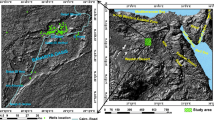Abstract
This paper shows the results of a comparative study involving application of the vulnerability mapping methods known as AVI, GOD, DRASTIC and EPIK to a pilot carbonate massif in southern Spain, namely the Torremolinos aquifer. The main objectives of the study were to determine which methods are most suitable for diffuse flow carbonate aquifers such as in southern Spain, and to evaluate variations in the degree of vulnerability associated to the rainfall variations that normally occur in a Mediterranean climate. According to three of the above methods, the aquifer is moderately vulnerable, but the AVI method evaluated it as highly vulnerable—this, however, is improbable. The vulnerability maps reflect the great importance of geology-related parameters (mainly those concerned with lithology) and, to a lesser degree, that of the depth of the groundwater table which is related to the rainfall. After this latter parameter, it is possible to distinguish between humid and dry climatic situations; thus, vulnerability increases in a humid year, especially according to the GOD and AVI methods. In conclusion, the GOD method seems the most adequate of the methods applied in this work for vulnerability mapping of diffuse flow carbonate aquifers in the Mediterranean domains.





Similar content being viewed by others
References
Adams B, Foster S (1992) Land surface zoning for groundwater protection. J Inst Water Environ Manage 6:312–320
Albinet M, Margat J (1970) Cartographie de la vulnerabilité a la pollution des nappes d’eau souterraine. Bull BRGM 2e sér. 3(4):13–22
Aller L, Bennett T, Lehr JH, Petty RH, Hackett G (1987) DRASTIC: A standardised system for evaluating groundwater pollution potential using hydrogeologic settings, US EPA Report 600/2-87/035, Robert S. Kerr Environmental Research Laboratory, Ada, Oklahoma, p 622
Andreo B (1997) Hidrogeología de acuíferos carbonatados en las Sierras Blanca y Mijas, Cordillera Bética, Sur de España. Service of publications of the University of Málaga, p 490
Andreo B, Carrasco F (1999) Application of geochemistry and radioactivity in the hydrogeological investigation of carbonate aquifers (Sierras Blanca and Mijas, southern Spain). Appl Geochem 14:283–299
Andreo B, Carrasco F, Sanz de Galdeano C (1997) Types of carbonate aquifers according to the fracturation and the karstification in a southern Spanish area. Environ Geol 30(3/4):163–173
Andreo B, Carrasco F, Durán JJ, Fernández del Río G, Linares L, López-Geta JA, Mayorga R, Vadillo I (2000) Hydrogeological investigations for groundwater exploitation in the Sierras Blanca and Mijas (Málaga, southern Spain). Hydrogéologie 3:19–33
Andreo B, Vías JM, Perles MJ, Carrasco F, Vadillo I, Jiménez (2002) Ensayo metodológico para la protección de aguas subterráneas en acuíferos carbonatados. Aplicación al sistema de Torremolinos. Jornadas sobre Presente y futuro del agua subterránea en España y la Directiva Marco Europea. Zaragoza (Spain). IAH-Spanish Chapter, pp 147–153
Civita M (1994) La carta della vulnerabilità degli acquiferi all’inquinamiento. Pitagora, Bologna
Daly D, Drew D (1999) Irish methodologies for karst aquifer protection. In: Beck B (ed) Hydrogeology and engineering geology of sinkholes and karst. A.A. Balkema, Rotterdam, pp 267–272
Daly D, Dassargues A, Drew D, Dunne S, Goldscheider N, Neale S, Popescu IC, Zwahlen F (2002) Main concepts of the European Approach for (karst) groundwater vulnerability assessment and mapping. Hydrogeol J 10:340–345
Doerfliger N, Jeannin PY, Zwahlen F (1999) Water vulnerability assessment in karst environments: a new method of defining protection areas using a multi-attribute approach and GIS tools (EPIK method). Environ Geol 39(2):165–176
European Water Framework Directive (2000) Directive 2000/60/EC of the European Parliament and of the Council of 23 October 2000 establishing a framework for Community action in the field of water policy. European Commission, Brussels
Foster S (1987) Fundamental concepts in aquifer vulnerability, pollution risk and protection strategy. In: Van Duijvenbooden W, Van Waegeningh HG (eds), Vulnerability of soil and groundwater to pollutants. Proc Inf TNO Comm Hydrol Res, The Hague 38:69–86
Gogu RC, Dassargues A (2000) Current and future trends in groundwater vulnerability assessment. Environ Geol 39(6):549–559
Goldscheider N, Klute M, Sturm S, Hötzl H (2000) The PI method—a GIS-based approach to mapping groundwater vulnerability with special consideration on karst aquifers. Z Angew Geol 46(3):157–166
Hötzl H (1996) Scientific basis for karst groundwater protection: guidelines and regulations. In: Antigüedad I (ed) Proceedings of the conference on groundwater resources on karst regions, Vitoria (Spain), pp 147–157
ICONA (1991) LUCDEME project. Soil map of Andalusia. Sheet 1066 (Coín) and 1067 (Málaga)
Longo CA, Andreo B, Carrasco F, Cucchi F, Vías JM, Jiménez P (2001) Comparison of two contamination vulnerability maps obtained by the SINTACS method in two carbonate aquifers (S Spain). In: Mudry J, Zwahlen F (eds) Proceedings of the 7th conference on Limestone Hydrology, Besançon, pp 233–236
Robins N, Adams B, Foster S, Palmer R (1994) Groundwater vulnerability mapping: the British perspective. Hydrogéologie 3:35–42
Van Stempoort D, Ewert L, Wassenaar L (1993) Aquifer Vulnerability Index (AVI): A GIS compatible method for groundwater vulnerability mapping. Can Water Res J 18:25–37
Vías JM (2003) Vulnerabilidad y peligro de contaminación en el acuífero carbonatado de Torremolinos (Málaga). Servicio Publicaciones de la Diputación de Málaga, p 180
Vrba J, Zaporozec A (1994) Guidebook on mapping groundwater vulnerability. International Association of Hydrogeologists, International Contributions to Hydrogeology, 16, Verlag Heinz Heise, Hannover
Zwahlen F (ed) (2004) Vulnerability and risk mapping for the protection of carbonate (karst) aquifers, final report (COST Action 620). European Commission, Directorate-General XII Science, Research and Development. Brussels, p 297
Acknowledgements
This paper is a contribution to European COST Action 620, to the projects IGCP 448 of UNESCO, REN2002-01797/HID and REN2003-01580/HID of the DGES and to the Research Groups RNM 308 and HUM 776 of the Junta de Andalucía. The comments of Prof. Alain Dassargues (University of Liège, Belgium), Prof. Jacques Mudry (University of Franche-Comté) and an anonymous reviewer are much appreciated.
Author information
Authors and Affiliations
Corresponding author
Rights and permissions
About this article
Cite this article
Vías, J.M., Andreo, B., Perles, M.J. et al. A comparative study of four schemes for groundwater vulnerability mapping in a diffuse flow carbonate aquifer under Mediterranean climatic conditions. Environ Geol 47, 586–595 (2005). https://doi.org/10.1007/s00254-004-1185-y
Received:
Accepted:
Published:
Issue Date:
DOI: https://doi.org/10.1007/s00254-004-1185-y




